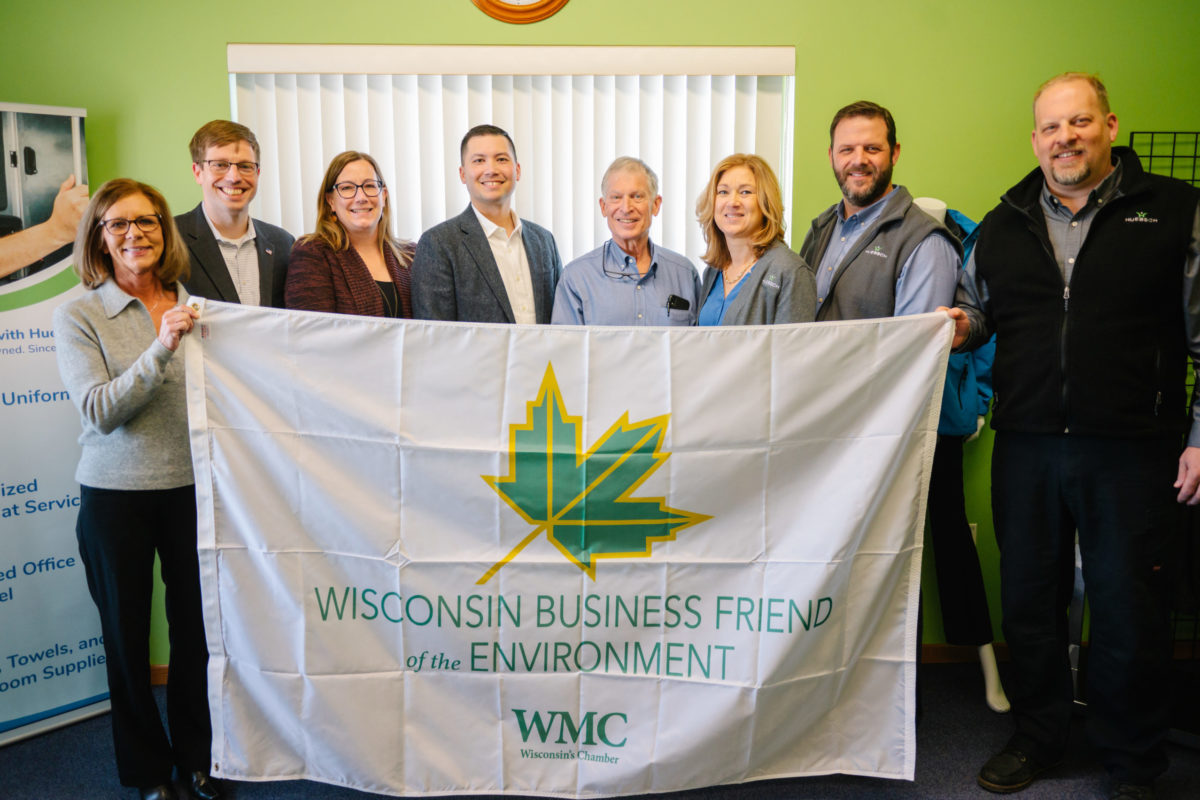The Business Friend of the Environment award highlights what Wisconsin companies are doing in the areas of sustainability, innovative technology and environmental stewardship. The goal of this awards program is to
technology and environmental stewardship. The goal of this awards program is to demonstrate to state policymakers, businesses and the public that sound environmental practices are good for Wisconsin and its business environment. The awards are given annually to companies that demonstrate environmental leadership.
demonstrate to state policymakers, businesses and the public that sound environmental practices are good for Wisconsin and its business environment. The awards are given annually to companies that demonstrate environmental leadership.
The awards focus on the following three areas:
- Sustainability
- Use of Innovative Technology
- Environmental Stewardship
This year, Huebsch Services was selected for a Business Friend of the Environment Award for its efforts in Sustainability in the Small business category. Huebsch installed a 100kw solar energy system at their Eau Claire production facility which provides one third of the energy needs for their entire Eau Claire facility. Huebsch also installed a stormwater retention system that holds and treats stormwater runoff to reduce sediments and other pollutants.
Managing Stormwater Run Off
Water that collects after a rain or snowmelt must go somewhere. It may pool and eventually evaporate or seep into the ground. It may follow the land and run into a stream or ditch. In either case, vegetation slows the water’s flow and helps filter out contaminants before the water runs into a stream or other stormwater collection point.
When a building, parking lot, or roadway is constructed on vacant land, those surfaces change the natural flow of water through the site. The runoff can carry debris, sediment, and potentially harmful substances into waterways and can cause erosion and heighten flooding.
There are several tools to reduce these negative environmental impacts. Detention basins temporarily store water during a rain or flood event in a large underground chamber, which allows for the settling of pollutants and sediment. The water is then released at a controlled rate to lessen harmful effects of erosion. Detention basins are likely the most common approach to stormwater management in the Chippewa Valley. Other options include green roofs, bioswales or bioretention areas (intentionally placed soil and plants that are used treat stormwater before it is discharged), and permeable pavement.
Huebsch Site Improvements, Operation, and Maintenance
The City of Eau Claire and the Department of Natural Resources (WDNR) require not just detention, but also treatment of the stormwater, and infiltration. An underground detention system provides all elements of these requirements. In addition, these systems need a maintenance program to assure the system keeps working as it was designed to.
maintenance program to assure the system keeps working as it was designed to.
At the Huebsch site, available land was limited for an above ground system, resulting in the only option available – an underground detention system. The design of the system was modeled using historical rain event data and footprint area of the building and parking lot. It was then compared to the City of Eau Claire requirements, and the system was sized to meet those requirements. A final report was written and the WDNR reviewed the information and provided a permit to install the stormwater management system.
The system consists of a 11 underground chambers of plastic pipe placed on soil with a network of pipes connecting each of the chambers. Stormwater is gathered from the roof and parking lot. The stormwater enters the first chamber (with a solid bottom) of the system called the treatment chamber. It removes most of the sediment and debris before it moves on to the next steps, infiltration and storage. It is important to remove these contaminates before the water is allowed to seep into the ground.
The next 10 chambers provide needed storage for large storms and floods. These chambers do not have a bottom, and as treated water enters these chambers, the water is allowed to seep into the open soil below. This also provides a recharge of the ground water, allowing water to continually flow downward into the water table. The area of Eau Claire on which the Huebsch site is located has extremely well drained sand, so as the water travels through the sand, it provides additional treatment. In this area, stormwater had previously entered the groundwater table too fast, so the installation required compost material to be placed underneath the chamber system to slow the infiltration rate down.
As the storm intensity increases, the chambers continue to release water into the soil below and are discharged to the city stormwater pipe network, but at a limited rate. This results in water being backed up into the storage chambers.
An important part of the continued function of the system will be yearly inspections and timely maintenance. There is a portal in the treatment chamber that can be accessed and can be used to measure the interior of the chamber to see how much sediment is building up. When sediment starts to build up in the treatment chamber, removal of the sediment is necessary by using a vacuum truck. To maximize the time between cleaning, some other actions may be taken. Sweeping the parking lot 2-4 times a year can pick up sediment and debris before it enters the treatment chamber. Erosion on other parts of the site should be immediately fixed to prevent further migration of sediment. Keeping the parking lot in good working condition is important, too. Making sure potholes, settlement around the inlets, and cracks in pavement need to be addressed before they become too large.
Good parking lot maintenance, and regular inspections will result in a system that provides many years of service.


